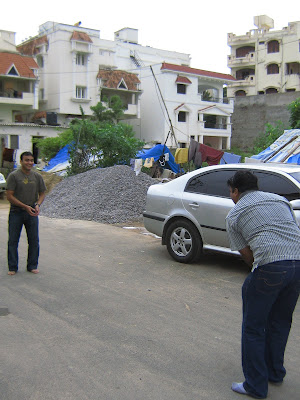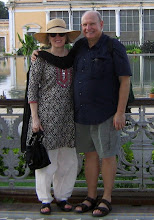
If nothing else has become crystal clear during our various trips here in India: It's always been better to be the king than to be the guy who sweeps up after the elephant. And Mysore is another example of this axiom. And talk about a love/hate/love/hate/and so on relationship with the British, Mysore is one of the prime examples. Look beyond the Hindu/Muslim change of hands ruling the principality of Mysore, the history even has Napoleon and Wellington involved in the outcomes of events in Mysore long before Waterloo. But enough of this part of the history. Mysore is celebrating 400 years of partying with the Maharajah for Dhurga Pooja or Desara or Denera or Chanapuramanasamanana, hey, hey, say goodbye. Oh, sorry, the festival that celebrates the story of Parvati, you remember, Shiva's consort, in which she defeats a demon that eventually the people of the area name the town after the defeated demon which just seems so strange to me, but then again, it's India.
Let's start out with where we spent the evening before the REALLLLLLYYYYY BIG party, which was the former home of the Maharajah's sister which, it goes without saying, it is good to be a family member of the king if you can't be the king.

The princess lived as a relative pauper to her brother's little shack, but it has that cosy feel that you get from any manor house. Our room was in the new section, so it tries to capture some of the sense of the style from the original open architecture like this shot off our balcony. Nothing terribly special about the Royal Orchid, but it was located in an enclave of princessly and princely homes near the palace. Since this was the 400th anniversary, the town swelled from the normal crowd for the celebration to more than double its size. People were pouring out of the train station looking for relatives or transportation or simply walking aimlessly in the general direction that everyone else was meandering. This meant that traffic was slowed beyond a snails pace.

Deb and I went to church in the evening and, lo and behold, a Gothic church of St. Philomena, though most of the Mysoreis call it St. Joseph for a reason I really couldn't figure out. And the school associated with the church was named "St. Mary's" which our guide, Mr. Kiren, attended as a boy. The church was a gift from the Maharajah. Go figure. For as large as the facade appears, the interior is rather small. This mass was celebrated in Kannada, the local language, so Deb and I got through with simply knowing the whats and whens of the mass. But it was as if you were at one second before Pentecost. Our obligation complete, we had planned to have our driver take us over to the palace to see the "must see" event which is the lights on the palace and surrounding buildings. Well, guess what, Deb and I and about a million of our close personal friends had the same idea. The traffic was stopped for blocks around the palace area, so we decided, with the advice of our driver, Mahaboob (thankfully drop the last "b" for the proper pronunciation) we decided to leave the car and walk to the palace and catch a tuck-tuck back to the hotel. Now, the weather in Mysore is relatively moderate, so everybody and I mean EVERYBODYYYYYYY, was walking to the palace. Here's what they were there to see:




Now I am not sure if they take all these lights down after the festival, but if they don't, they are in good company as most of the folks at the trailer park near us in New Jersey leave their Christmas lights up all year long as well. After a short time, the crowds started to become more unnerving than exciting, so Deb and I fought our way through to the gate, found a spot where we eventually hailed a rickshaw who gave us the price he was looking for, wouldn't budge and we were on our way. However, not knowing the city, and being at night, Deb was nervous that the guy was going to run us all over the city, stop and say it'll be another 10000 Rs to get us back to the hotel. So sorry. But he didn't and we got back to the court yard filled with lights.



Earlier in the day, we toured the summer palace of Sultan Tipu, a local hero (of sorts)who took on the British with a little help from the French. Remember, Pondicherry isn't too far away that an expeditionary force couldn't come from there to Mysore with much trouble. And they did, defeating the British before the future Duke of Wellington and then Lord Cornwallis, yeah the guy who lost the Americas, came to reassert British authority, which they did.
But Tipu, preceded by his father, was a wheeler-dealer in politics. He enlisted the Nizam of Hyderabad to help him beat the British, with French help, but the Nizam thought better of the deal and backed out, eventually making nice-nice with the British (and his dynasty made boat loads of money because of it). But Tipu had a summer palace which was pretty nice place down by the riverside, down by the riverside, down by the riverside, oh Tipu had a summer palace down by the riverside. Sorry, just get caught up in the whole royalty thingy. The first photo is of the forerunner of e-mail which was pigeon mail. Tipu had two of these on the palace grounds to keep in contact with what was happening around the principality.




Well, Tipu is considered one of the first Indian freedom fighters to free them from the yoke of British oppression, just like the Americans did (with the help of the French). Well, two things happened. Wellington came and defeated Tipu by sending his troops through the Watergate entrance to the palace, which Tipu didn't count on. In fact, Tipu didn't count on much else since he was killed during the storming of the fort.

But he ended up in the tomb with his mom and dad. But Tipu's wife ended up outside the tomb in the general family graves because it was her brother, Tipu's defense minister who gave away the Watergate entrance to the British. In fact, Tipu's wet nurse got a better spot just outside the door to the tomb than Tipu's wife, though her stone is shrouded with a royal cover.




Next posting will be about Bangalore. Look for it soon.
 Well, Deb and I tried to bring a little American culture to our Hyderabad neighborhood and we were very successful because there is so little American culture left that we bumped up against the Halloween cultural contribution limit at about 98%. If I could have found some of the orange icicle lights, we'd have made it to100%. For our Southeast Michigan friends, you might recognize Tom Ryan's "Count Scary" in the title. Between Tom Ryan and Dick Purtan, I have some of my fondest Deeetroit radio memories.
Well, Deb and I tried to bring a little American culture to our Hyderabad neighborhood and we were very successful because there is so little American culture left that we bumped up against the Halloween cultural contribution limit at about 98%. If I could have found some of the orange icicle lights, we'd have made it to100%. For our Southeast Michigan friends, you might recognize Tom Ryan's "Count Scary" in the title. Between Tom Ryan and Dick Purtan, I have some of my fondest Deeetroit radio memories.


 They started out at the bowling alley. Deb had been wearing bowling shoes before this picture. Some other players on the lanes next to us bowled barefoot.
They started out at the bowling alley. Deb had been wearing bowling shoes before this picture. Some other players on the lanes next to us bowled barefoot. You guess who you are by asking questions. Deb was Bill Gates.
You guess who you are by asking questions. Deb was Bill Gates. We had bobbing for apples
We had bobbing for apples And carved pumpkins. There were no large pumpkins like we're used to in the US because they would be eaten before they could be carved.
And carved pumpkins. There were no large pumpkins like we're used to in the US because they would be eaten before they could be carved. And we mixed the Diwali and Halloween themes which was another China Town-Faye Dunaway revelation moment.
And we mixed the Diwali and Halloween themes which was another China Town-Faye Dunaway revelation moment.
 But everyone seemed to have a great time. And the spider on the balloons was a decoration. I've only found cockroaches that big.
But everyone seemed to have a great time. And the spider on the balloons was a decoration. I've only found cockroaches that big.
 And carved pumpkins. There were no large pumpkins like we're used to in the US because they would be eaten before they could be carved.
And carved pumpkins. There were no large pumpkins like we're used to in the US because they would be eaten before they could be carved. And we mixed the Diwali and Halloween themes which was another China Town-Faye Dunaway revelation moment.
And we mixed the Diwali and Halloween themes which was another China Town-Faye Dunaway revelation moment.
 But everyone seemed to have a great time. And the spider on the balloons was a decoration. I've only found cockroaches that big.
But everyone seemed to have a great time. And the spider on the balloons was a decoration. I've only found cockroaches that big.












































